Island Peak Climbing is a 20-day expedition that draws adventurers to the stunning Khumbu region of Nepal. Standing at 6,189 meters, this trekking peak not only offers breathtaking views of the mighty Himalayas but also presents significant challenges, from altitude sickness to the need for technical climbing skills. Participants start their journey in Kathmandu, gradually acclimatizing while exploring charming villages and ancient monasteries. However, as they prepare for the ascent, they must confront critical questions about fitness, gear, and strategy. What does it truly take to summit this iconic peak?
Good To Know
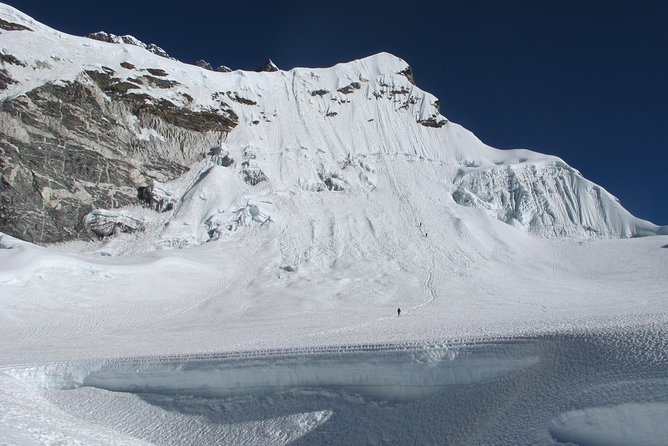
- The Island Peak climbing adventure lasts 20 days, allowing ample time for acclimatization and exploration in the Khumbu region of Nepal.
- The itinerary includes key stops such as Kathmandu, Lukla, Namche Bazaar, and Everest Base Camp before the summit attempt.
- Climbers must prepare for a challenging ascent involving a 300-meter headwall and 45-degree snow slopes requiring technical skills.
- Essential gear includes mountaineering boots, crampons, and layered clothing suitable for extreme cold and high-altitude conditions.
- Total cost for the expedition starts at $3,250, covering logistics, accommodations, and essential services.
Overview of Island Peak
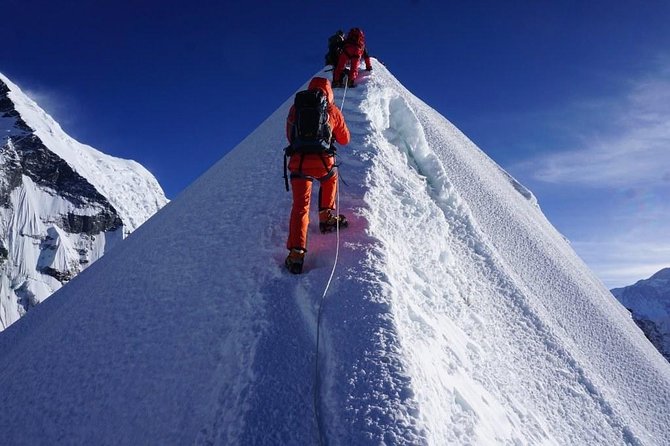
Island Peak, standing at an impressive 6,189 meters (20,305 feet), is a popular trekking peak in the Khumbu region of Nepal, attracting climbers from around the globe.
Its allure lies not only in the thrilling ascent but also in the breathtaking views from the summit. Climbers are rewarded with stunning panoramas of towering giants like Nuptse, Lhotse, and Makalu, among others.
The final climb features a challenging 300-meter headwall with steep 45-degree snow slopes leading to the summit ridge.
With a duration of 20 days, this adventure requires strong physical fitness, making it suitable for those ready to embrace the challenge.
You can also read our reviews of more tours and experiences in Kathmandu.
Itinerary Breakdown
The itinerary for climbing Island Peak is designed to provide a well-paced journey through the stunning landscapes of the Khumbu region.
Over 20 days, climbers will acclimatize and explore breathtaking vistas, starting with their arrival in Kathmandu. They’ll prepare for the adventure before flying to Lukla and trekking to Phakdingma.
The journey continues to Namche Bazaar for acclimatization, followed by treks to Tengboche and Dingboche. An additional acclimatization day allows for hikes around Nagarjun Hill or Chukhung Valley.
Climbers then head to Lobuche and Gorak Shep, where they’ll hike to Everest Base Camp.
This carefully planned itinerary balances trekking and acclimatization, ensuring climbers are well-prepared for the ultimate summit attempt on Island Peak.
Costs and Inclusions

Climbing Island Peak involves a range of costs and inclusions that cater to both the logistical needs and comfort of trekkers. The total cost starts at $3,250, covering essential services such as private vehicle transfers between the airport and hotel.
Accommodation includes four nights in Kathmandu on a twin-share bed and breakfast basis, ensuring a comfortable stay. Trekkers can budget $10 to $14 per meal for lunch and dinner in local restaurants.
Additional inclusions consist of personal travel insurance and the Nepal entry visa fee. It’s important to note that the cancellation policy is non-refundable, emphasizing the need for commitment.
Journey to Base Camp
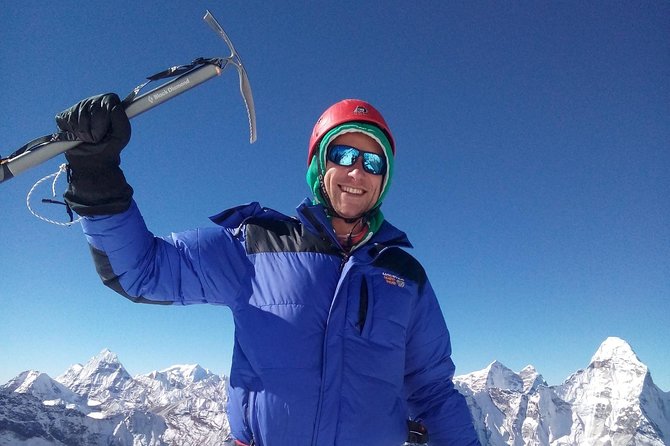
Embarking on the journey to Base Camp is an exhilarating experience that combines breathtaking scenery with the thrill of adventure.
Travelers start by flying to Lukla, where they’re greeted by stunning mountain views and a vibrant village atmosphere. The trek to Phakdingma, followed by a scenic ascent to Namche Bazaar, immerses them in the heart of the Khumbu region.
Acclimatization days in Namche help climbers adjust to the altitude, ensuring a safer and more enjoyable trek. As they continue to Tengboche and Dingboche, they encounter ancient monasteries and majestic peaks, each step revealing new vistas.
The journey culminates in reaching Gorak Shep, where climbers prepare for their final trek to Everest Base Camp, setting the stage for the adventure ahead.
Climbing Challenges

Facing the ascent of Island Peak presents a unique set of challenges that climbers must navigate. The combination of altitude, unpredictable weather, and technical terrain can test even experienced mountaineers. Climbers must acclimatize properly to avoid altitude sickness, while the snow and ice slopes demand proficiency in using climbing gear.
| Challenge | Description |
|---|---|
| Altitude Sickness | Risk of headaches, nausea, and fatigue at high altitudes. |
| Weather Conditions | Sudden changes can lead to dangerous conditions. |
| Technical Skills | Requires proficiency in using crampons and ice axes. |
| Physical Endurance | Sustained effort is needed for long, steep ascents. |
Understanding these challenges prepares climbers for the journey ahead, ensuring they approach Island Peak with the right mindset and skills.
Essential Gear List
Preparing for the ascent of Island Peak requires careful consideration of the gear climbers will need to tackle the unique challenges of the trek.
Essential items include a durable pair of mountaineering boots, crampons, and an ice axe for navigating icy terrain. Climbers should also pack a warm sleeping bag rated for sub-zero temperatures, a lightweight tent, and a reliable stove for cooking meals.
Layered clothing, including moisture-wicking base layers, insulating mid-layers, and waterproof outer layers, is crucial for varying weather conditions. Don’t forget gloves, a warm hat, and sunglasses to protect against the sun’s glare at high altitudes.
Lastly, a comprehensive first aid kit and personal medications ensure safety throughout the adventure. Proper gear selection enhances the climbing experience significantly.
Customer Testimonials
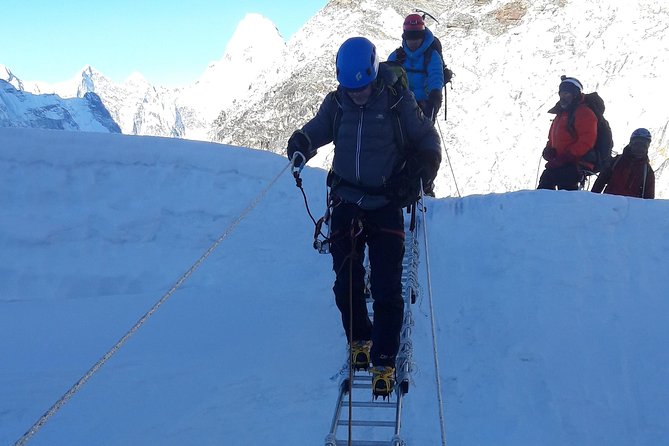
Climbers often share their experiences to highlight the transformative nature of the Island Peak adventure. Many guests commend the exceptional guidance provided by Tenzing and Mingma, noting their attentiveness and problem-solving skills. The trek is often described as a blend of breathtaking views and remarkable camaraderie among participants.
Here’s a snapshot of the feedback received:
| Review Aspect | Comments |
|---|---|
| Guides | "Tenzing and Mingma were amazing!" |
| Mountaineering Experience | "Outstanding and unforgettable!" |
| Comfort | "Felt at ease throughout the trek." |
| Organization | "Everything was perfectly arranged." |
| Overall Rating | "5 stars based on our experience!" |
Tips for Success
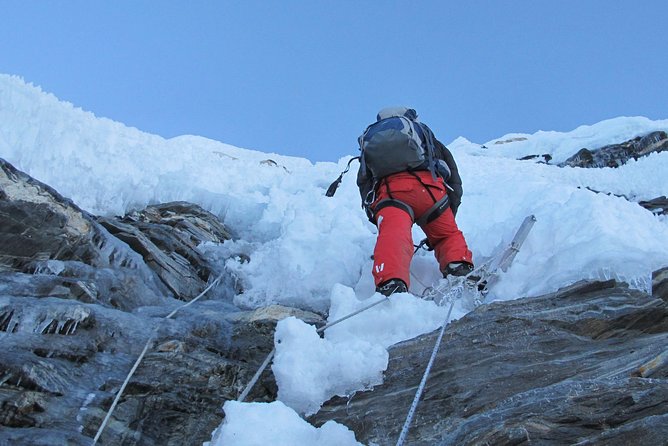
Success on the Island Peak climbing adventure hinges on a few key strategies that can enhance the overall experience.
First, climbers should prioritize physical fitness by engaging in regular training, including cardio and strength exercises, to prepare for the challenging trek.
Second, acclimatization is crucial; taking time to adjust to the altitude will help prevent altitude sickness.
Third, proper gear is essential—investing in quality clothing and equipment tailored for cold weather can make a significant difference.
Plus, staying hydrated and well-nourished during the journey will boost energy levels.
Frequently Asked Questions
What Is the Best Time to Climb Island Peak?
The best time to climb is during the pre-monsoon months of April to May and post-monsoon months of late September to October. These periods offer stable weather, clearer skies, and optimal conditions for trekking and summiting.
Are There Any Age Restrictions for Participants?
There aren’t strict age restrictions for participants, but guides recommend climbers be at least 16 years old. They emphasize physical fitness and experience over age, ensuring everyone has a safe and enjoyable adventure.
How Experienced Do I Need to Be for Climbing?
For climbing, participants need a strong physical fitness level and some prior trekking experience. While technical skills aren’t mandatory, familiarity with altitude challenges enhances safety and enjoyment during the ascent, ensuring a rewarding adventure.
Is Altitude Sickness a Concern During the Trek?
Altitude sickness can definitely be a concern during the trek. Climbers often acclimatize gradually, monitor symptoms, and stay hydrated. Guides provide support, ensuring everyone stays safe and enjoys a memorable experience amidst breathtaking landscapes.
What Is the Group Size for the Expedition?
The group size for the expedition is private, meaning only your group participates. This arrangement fosters a personalized experience, allowing for tailored itineraries and enhanced camaraderie among participants, ensuring an unforgettable adventure together.
The Sum Up
Island Peak climbing promises an unforgettable adventure for those seeking to conquer the heights of the Himalayas. With its breathtaking views and rich cultural experiences, trekkers can embrace the challenges and triumphs along the way. By preparing adequately and staying physically fit, climbers can increase their chances of reaching the summit. Ultimately, this journey not only tests one’s limits but also creates lasting memories in the heart of Nepal’s stunning landscape. Adventure awaits those ready to take the plunge!
More Tour Reviews in Kathmandu
Not for you? Here's more nearby things to do in Kathmandu we have reviewed
- From Lukla: Everest Base Camp (EBC) 10-Day Trek
- Kathmandu : Everest Mountain Flight – with Private Transfers
- Full Day : Kathmandu Sightseeing By Bus Day Trip
- Kathmandu: 7 UNESCO World Heritage Sites Day Tour
- Kathmandu: 8-Day Langtang Valley Trek with Transfers
- Thamel Rickshaw Tour
- Everest View Motorbike Tour- 6 Days
- Kathmandu: Top 4 UNESCO Sites Private/Group Tour with Lunch
- From Oceans to Mountains-9 Days (Nepal Guided Tour)
- From Kathmandu: Everest Base Camp Helicopter Tour landings
- Kathmandu: Food and Drink Walking Tour
- Life and spirituality tour of Kathmandu
